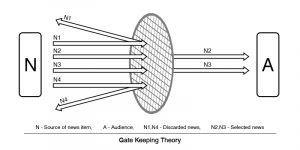Billions of events take place around the globe in a single day. People cannot access them all, so they use these mediators to manage the information according to relevancy and proximity.
Gatekeeping is the information managing process by media for selecting information to be broadcasted in media on the basis of the type of information, content, nature of information, type of event, etc.

The process explains why and how some information are published and some are not. Gate is the choosing criteria which is used to select information to be given in the media or blocking unwanted things. When gatekeeping is done, the view of audience is affected.
The word gatekeeping was proposed by Kurt Zadek Lewin in 1943, who was a social psychologist. The theory was used for mass communication and news dissemination by David Manning White.
Concepts in Gatekeeping Theory
Gatekeeping is the process of selection of information according to importance and relevance. The information is also published according to the amount of importance the media wants the information to have.
Gatekeepers establish a hierarchy of information which people need to look at as important and the perceived to be a need. They have a great responsibility to provide unbiased, true information. Lewin used “unfreeze – change – refreeze” approach for gatekeeping which suggests that information must be edited after unfreezing it, changed what is says and then refreezed. The refreezed version is then available to audiences.
Criteria of selecting depends on the issues that affect many people, controversial topics, and issues that can be the most popular.
Factors of Gatekeeping
The factors that influence gatekeeping are:
- Individual:
Journalist who creates the report is the person who is the most influential to make the news article. Other gatekeepers just change some aspects of the news but the reporter states truth. - Routine:
The themes shown in the news and other media is always in a pattern. Media also have schedules to follow and have allocated time for each category. - Organization:
Media organizations have their own views, agendas and propaganda. They also have to follow certain rules and ethics. The news or other media products has some elements of the media house’s opinions and views. - Extra-Media:
Many media related people and institutions have a say in what is published like sponsors, advertisers, government, etc. - Ideology:
The societal ideologies must be followed by media as it influences what is reported. The norms and values of people must be respected by media. Similarly, ethical issues must also be taken care of.
New technologies have let journalists to expand the number of audiences and increased the rate of interactions with them(audience). Gatekeeping process has changed with it too as anyone can publish anything. Though there are still issues of credibility.
Features of Gatekeeping Theory
- It is a process of selection and filtering of items for media and editing it as per the requirements like limited time or space.
- The function of gatekeeping is surveillance.
- Gatekeeping sets the standard for newsworthiness.
- Editor who works as a gatekeeper changes news as the person has his/her own subjective perceptions.
- Media plays a role of a watchdog.
- There are many factors for gatekeeping like the organizational policies.
- The theory is descriptive with normative traits.
- Information moves in a step by step process in a structure.
- It is also used as a social control for media influence.
Examples of Gatekeeping Theory
Ice skating is not popular in countries with tropical climate. If the media of those countries show those issues, people will not have any interest and might totally skip the page or change channels in television. The topic is not appropriate for the area but can be very famous topic for countries like South Korea or Finland. The editor must try to replace the story with something else.
Similarly, in a country having a civil war, if media publishes one sided story, the war will become more ferocious. So, the editors must see to it that the news published is not supporting one side and victimizing them.
For instance,
N is the source of the news
N 1,2,3,4 are news items
N 1, 4 are not selected news items
N 2, 3 are selected news items that passes through gate
M is the audience

Here,
N is a journalist
N1 is news on rain in Norway
N2 is news on turmoil in Syria
N3 is news on Barack Obama
N4 is news on problems of local youth meeting
M is the audience living in the U.S.
Gatekeeper is the editor of a national level newspaper.
N2 and N3 are selected news as N2 is an important international issue. Whereas, N1 and N4 are discarded as one is an unimportant international news and the other is local news which is not of interest in national level. The audience only gets to listen to N2 and N3 as the other two is not selected by the editor. If the editor is biased, newspaper will be biased and create prejudices among people.
Burma can be taken as a perfect example of gatekeeping in media. Media is controlled by government and censor all international news that can affect the Burmese government. Government acts as a single and most powerful gate.
Gieber was a researcher who investigated 16 daily newspapers and found that editors thought of the top news to be their utmost responsibility. Other responsibilities were content and structure.
Criticisms of Gatekeeping Theory
- The theory suggests there is only one gate, but in reality, there might be many.
- Gatekeepers themselves are wired to think in a specific way.
- Editors and other gatekeepers change the priority of news causing influence in society like racism, sexism, classism, etc.
- It can cause negative presentations and abuse of power.
- The reality might not be shown as it is.
- The theory also has appeal as well as plausibility and applicability.
- Gatekeeping has become less in today’s news broadcast due to internet media and people posting anything and everything.
[Related Reading: Social Marketing Theory]
